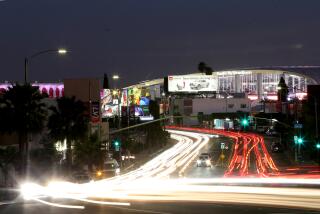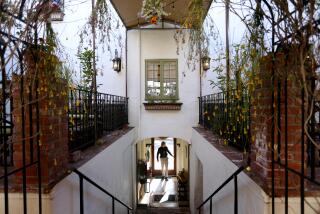Irwindale Votes to Save Old Guadalupe Mission
Irwindale, a rapidly industrializing city of shiny new business parks, restaurants and gravel pits, is about to make a new acquisition: a tiny stone chapel built by hand by the city’s first settlers 73 years ago.
After lengthy negotiations with the Archdiocese of Los Angeles, the City Council unanimously voted Feb. 22 to purchase Our Lady of Guadalupe Mission, and to make costly earthquake renovations to the structure.
“This is so the future generations will know their forefathers built it,” Councilman Patricio Miranda said.
The 100-by-200-foot mission, dwarfed over the years by development and redevelopment along Arrow Highway, was closed by the archdiocese in 1988, after engineers determined that its unreinforced walls might not withstand a major earthquake. The archdiocese said it could not afford to spend $100,000 on steel reinforcements and other structural additions to the mission.
Irwindale officials will pay the archdiocese $270,000 for the mission and an adjacent lot. They have promised to make the necessary improvements and to preserve it as a historic landmark.
To parishioners, however, the city purchase is a mixed blessing. Irwindale’s ownership of the church means the long tradition of Roman Catholic baptisms and marriages in the small mission will end because the city is constitutionally barred from operating a place of worship. City Manager Charles Martin said, however, that Catholics and members of other religious and secular groups would be allowed to hold occasional ceremonies at the church with city permission.
“I’m sad. I’m very sad,” said Margaret Barbosa, 62, whose grandfather, Meliton Cruz, was among the Irwindale residents who helped build the mission.
“The little mission had something special in it,” Barbosa said. “I don’t mind sharing it but I wish it would remain as a Catholic church.”
The mission’s seemingly sturdy exterior belies a need for seismic improvements. It sustained minimal damage in the 1987 Whittier Narrows quake, showing only a few faint cracks in the stone walls, said Father Patrick M. Hughes, pastor of Our Lady of Guadalupe parish. But it was designed and built by volunteers who used donkeys, horses and wheelbarrows to transport thousands of rocks from the nearby San Gabriel River.
Women made tamales and tostadas for the workers, according to a booklet detailing the mission’s history, written in 1969 by Father Anthony Z. Marigo, the church’s first full-time priest. Children sold raffle tickets to buy cement for the foundation. And in 1917, when Our Lady of Guadalupe Mission was completed, the first Mass was celebrated using a rough, handmade table as an altar and linens and candles borrowed from the nearby Azusa parish.
As a little girl, Barbosa said, she and her friends would stand outside the mission as their mothers took turns cooking meals and doing laundry for the priests. At Christmastime, they would march behind the priest in a solemn Las Posadas procession. In 1947, Barbosa and her husband, Henry, were married in the church.
Because of the shortage of priests, Sunday Masses were held irregularly. At times, Irwindale residents had to walk to St. Francis of Rome Church in Azusa for services. Finally, in 1964, the area around the tiny Irwindale mission was officially declared Our Lady of Guadalupe parish.
In 1965, the archdiocese built a 700-seat Our Lady of Guadalupe Church at Cypress Street and Irwindale Avenue to replace the 90-seat mission, which was then relegated to ceremonial use. The last service there was in August, 1988, a memorial Mass for Father Marigo.
The city plans to ask the state Office of Historic Preservation to designate the mission a national landmark. The archdiocese will give the money from the sale to Our Lady of Guadalupe parish, which is composed of 1,250 families and includes parts of Azusa, Covina, West Covina and Irwindale, Hughes said.
The city’s decision came after 15 months of stalled negotiations and speculation on the fate of the church. For a while, the city considered leasing the building but decided it wasn’t economically feasible, City Engineer Carlos Alvarado said. Last year, after the council rejected an initial purchase agreement, the archdiocese put the mission up for sale. Soon afterward, rumors spread that the building would be demolished.
Even after it passes into city hands, some residents say they still want to have a say in the mission’s upkeep.
“We maintained it,” said Theresa Chico, 38, president of the Guadalupanas, a group of parishioners who have taken turns cleaning and fixing up the mission over the years.
“It’s the people’s church.”
More to Read
Sign up for Essential California
The most important California stories and recommendations in your inbox every morning.
You may occasionally receive promotional content from the Los Angeles Times.










